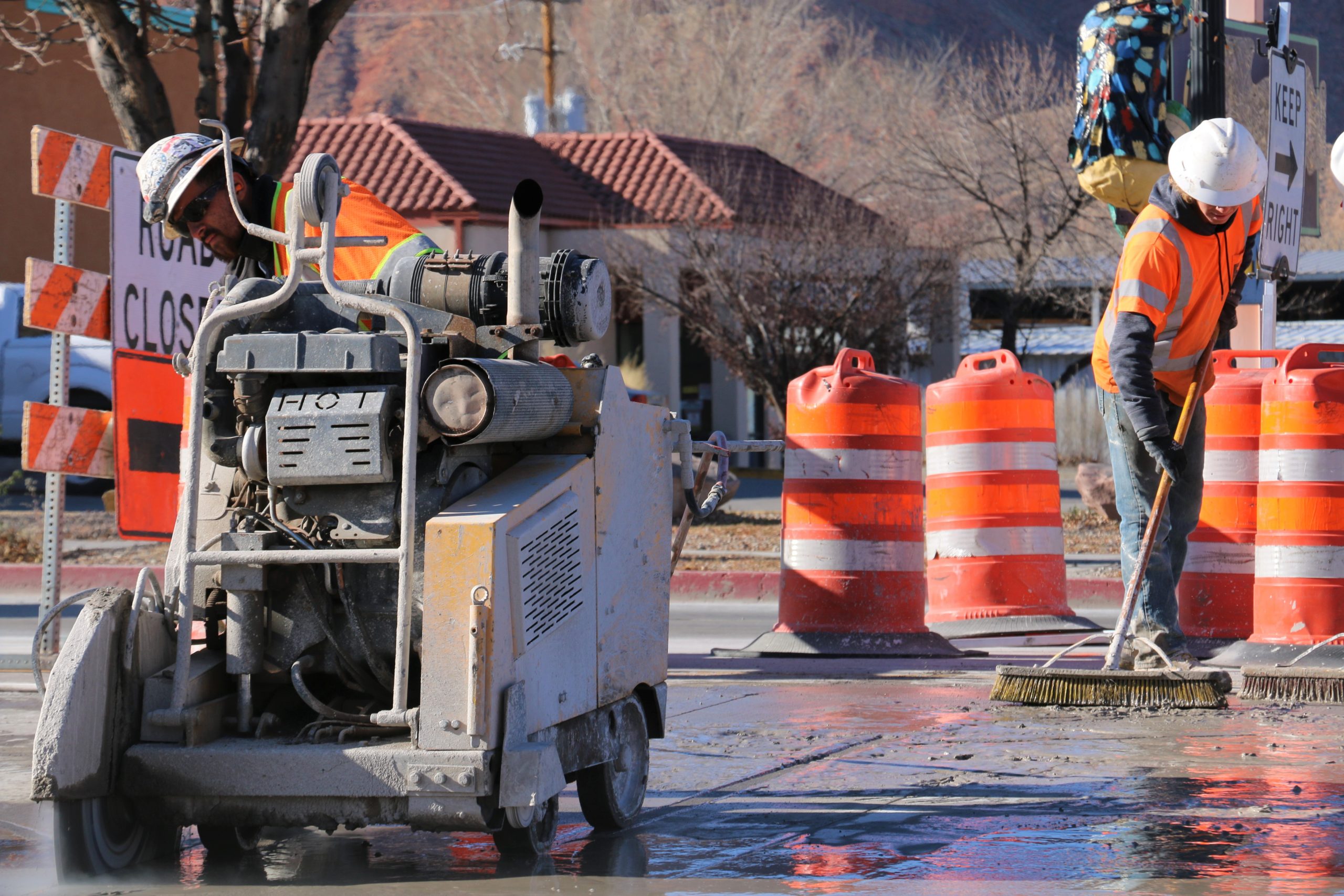Some information may be outdated.
A major highway that cuts through the middle of town, with 3,500 to 4,000 trucks traveling across its surface every day, is bound to need a little maintenance work now and then. And that time has come for Moab’s Main Street, also known as U.S. Highway 191.
For the next two months, motorists may need a little patience as one lane of traffic will be closed for much of the time as the Utah Department of Transportation (UDOT) checks for wear and tear on Moab’s main artery.
“Those heavy trucks are tough on a road,” Moab City Engineer Chuck Williams said during a Dec. 12 city council meeting. “(Contractors are) cutting out the broken areas and then replacing them with new concrete … They’re patching large blocks of concrete.”
Fixing and replacing concrete slabs was phase one of the project and is largely completed. Phase two, which involves grinding the concrete to smooth out surfaces, is expected to be completed by Christmas Eve.
“Then, we’ll take a break for the holidays and come back in January,” Utah Department of Transportation Regional Communications Manager Kevin Kitchen said.
Traffic controls on the affected streets will be removed during the break. In January, phase three will begin, with work on the joints between the concrete slabs, as well as other “fine-tuning” of the roadway, including the painting of new pavement markings, such as turn arrows and stop bars.
“Typically, over time we need to replace the seals between the concrete panels, as they settle,” Kitchen said. “It’s ongoing maintenance that we do every decade or so.”
A UDOT subcontractor crew will also work on the Mill Creek Bridge, between 100 and 200 South, starting the second week of January, and lasting until Valentine’s Day. Workers will check for potholes that require patching, concrete that needs to be ground down to a smooth surface, or joints that need new seals, Kitchen said.
“Then, in the spring, we’ll come back and apply a final polymer overlay coating on the bridge,” which requires warmer temperatures, the UDOT spokesperson said. “We’ll be looking at re-surfacing the deck on top of the bridge and anything associated with the immediate deck.”
The maintenance crew will check for drainage problems, ensuring that surfaces are watertight and will not cause structural problems down the road, Kitchen added.
The road construction began on Dec. 17, with a major portion of the work expected to be completed by February. Most of the bridge work should be finished by Valentine’s Day, with some follow-up work to occur in April.
“Operationally, people will notice they won’t be able to make a left turn for a limited time onto different cross streets,” Kitchen said. Making left turns from the center turn lane will not be possible in either direction at 200 and 300 South.
Motorists should know that even when nobody is working on the road, a lane may be closed because the concrete needs time to “cure,” Kitchen said.
“We really appreciate how good the community has been,” he said. “We know construction can be noisy; we hope it’s not too disruptive to businesses.”
Amanda Domenick, owner of Tumbleweed, a shop with local art and handcrafted goods, at 31 N. Main St., said she hasn’t been bothered at all from the maintenance work going on.
“It’s not been detrimental,” she said. “One advantage I’m having is people are parking on the west side (of Main Street),” while the east lane is closed during construction.
“It’s quiet this time of year anyway,” she said. “If there’s any time to do it, now’s a good time.”
Back of Beyond Books owner Andy Nettell agrees that winter is the best time to do the road maintenance, and said that it hasn’t hurt his business. He has received feedback, however, about the lack of parking since the construction began.
“The locals know the side roads, but for the tourists, it’s more difficult,” he said. “It’s very clearly marked on the east side (of Main Street) ‘no parking,’ but they didn’t put signs as to where people should park.”
Beginning Tuesday, Jan. 2, 2018, new construction traffic controls will be installed and pavement repair work will resume.
“I’m not surprised that sections need to be repaired – it’s been 10 years,” Williams said. “All roads have to be maintained. It’s like changing the oil in your car – you got to do it.”
The cost of the project is $1 million, paid for with UDOT funds – not city taxpayer money. Moab’s Main Street, also a state highway, is a responsibility of UDOT, which controls the right-of-way.
After calling for bids on the project, UDOT contracted with Dry Creek Structures, LLC – a Lehi, Utah-based company that does a lot of bridge work throughout the state, Kitchen said.
UDOT sends out weekly updates with the most current work schedule and its expected impacts. To sign up for a weekly email update regarding the project, email: shenriksen@utah.gov, or call the hotline at 1-800-948-8286.
UDOT on schedule, but says motorists should expect downtown lane closures as concrete “cures”
Appreciate the coverage? Help keep local news alive.
Chip in to support the Moab Sun News.





